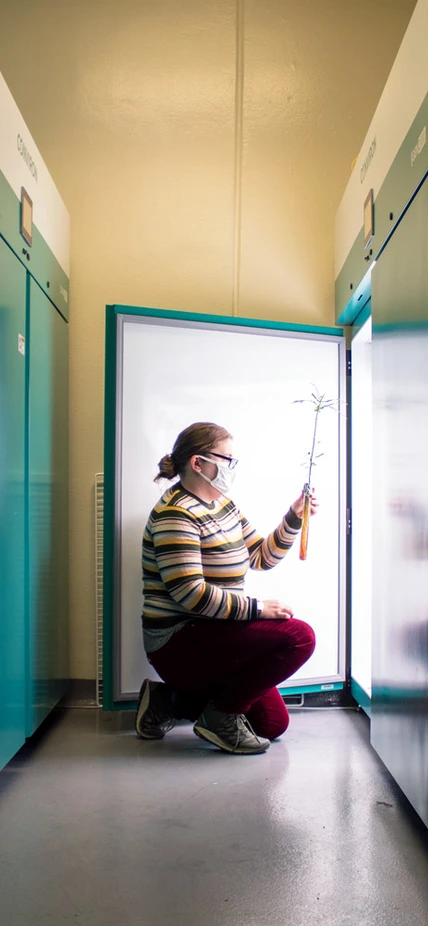Baltimore, MD — Kneeling among the plant growth chambers at Carnegie’s Department of Embryology in Baltimore, MD, Dr. Brittany Belin inspects a young African jointvetch, a flowering legume native to the West African floodplains.
Belin, who joined Embryology as a principal investigator last summer, studies the biology of rhizobia, soil bacteria that can convert atmospheric nitrogen gas into plant-fertilizing ammonia. These “beneficial bacteria” form a symbiotic relationship with legumes such as peas, soybeans, and jointvetch, serving as sustainable alternatives to synthetic nitrogen fertilizers.
This type of mutually beneficial arrangement with specific bacteria can keep plants healthy in the face of climate change, and Belin believes that harnessing this powerful interconnection has the potential to transform agriculture. One day, bacteria could help to naturally and sustainably feed the world’s rapidly growing population.

"These are baby plants," explains Belin, pointing to the tiny African jointvetch. "They don't have any fertilizer other than the rhizobia bacteria we give them. We don’t add carbon or nitrogen, which forces the two partners to interact with each other. The plants can get fixed carbon such as sugars from photosynthesis, and the bacteria can make ammonia fertilizer from nitrogen fixation, so they're dependent on each other to survive. We force the symbiosis to develop—there's no other way for the plant to get nitrogen or for the bacteria to get carbon."
DID YOU KNOW?
Bacteria are the only organisms on Earth that can fix nitrogen, partly because this process almost always occurs in an environment where there's virtually no oxygen. Unlike mammals and most eukaryotes, many species of bacteria do not need oxygen to survive!

One of the molecular processes the Belin Lab is trying to understand is how lipids called hopanoids—bacteria’s version of cholesterol—facilitate the symbiosis between rhizobia and plants. As you can see in the image above, only the plants that were supplied with normal, hopanoid-producing bacteria grow well.
From left to right:
-
Two rows of African jointvetch which host mutated bacteria that prevent them from making hopanoids.
-
African jointvetch in symbiotic relationships with normal bacteria.
-
African jointvetch with no beneficial bacteria.

Members of the Belin Lab spend many hours looking at specific types of lipids in bacteria. Here, Brittany Belin and lab tech Evan Lawrence compare different strains of rhizobia, which have been dyed to reveal how hopanoids affect their cell membranes.
They already know that a lack of hopanoids makes for a weaker symbiotic relationship—particularly in jointvetch—but hope to discover why.
“We’re a microbiology lab, but we are interested in which genes make rhizobia better for one host versus another,” explains Belin. “Can you improve the strain to make it more useful for agriculture? What would be the consequences of having this GMO bacterium in the environment—is that long-term a good thing to do? That’s the kind of stuff we think about.”

The membrane of a single cell of bacteria is so small that it is almost impossible to image—even with the most advanced microscopes. To solve this problem, rotation student Jonathan Seaman binds a bacterial cell to a special expanding gel. As it expands (just add water), so will the cell, increasing in size up to tenfold. When viewed under a microscope, this compound will give Seaman a much better understanding of the relative positions of proteins and other molecules in the cell—a critical advantage.
Just to make one molecule of ammonia requires more energy than almost any other chemical reaction that organisms can do. To supply the plant with enough ammonia, rhizobia need lots and lots of sugar.

To establish symbiosis, rhizobia enter the plant’s tissue to induce it to form root nodules, protrusions that house a large population of bacteria and protect them from attacks by other microbes. These nodules contain rhizobia’s optimal chemical environment, allowing the bacteria to perform nitrogen fixation at an extremely high rate.
Hunting for root nodules in the image above, rotation student Audrey Heffner compares a mutant strain of rhizobia that lack hopanoids against a wild-type, or “normal” strain. Heffner, a Johns Hopkins University graduate student, is searching for how hopanoids affect the nodule formation in jointvetch—and how this relates to the symbiotic process as a whole.

African jointvetch is not available for purchase, so the Belin Lab has to farm their own seeds. Unfortunately, deer have a penchant for it, and the hungry creatures are a common sight on the grounds of Carnegie Embryology. So, Belin turned to a cannabis supply store for the answer: indoor hydroponic grow tents.
“We can change the type of nutrient solution the plants have every single week,” explained Belin. “Have them grow really big in the beginning and then push them to flower and seed production, just like any home gardener would.”

“The research support I get from Carnegie helps to fill the crucial gap in government funding for sustainable agriculture,” says Belin. “It is great to see how our Carnegie-supported work on beneficial soil bacteria might someday make sustainable farming a little easier.”
To learn more, visit: belinlab.org
